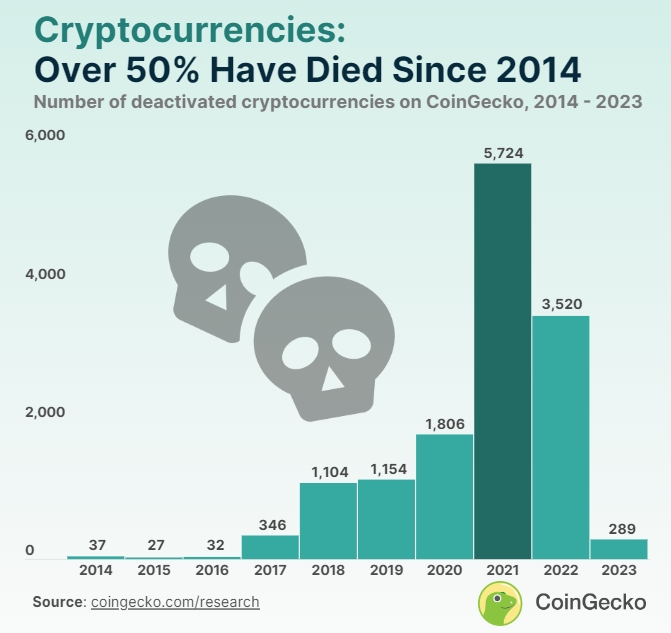and the distribution of digital products.
DM Television
Zombies Among Us: Deadcoins & How to Spot Them
We have zombies from past crypto eras lurking on some exchanges and personal wallets: they’re called ‘deadcoins’. Sometimes, you can't tell a "live" coin from a dead one at first glance. If you hit buy or trade, the rotten thing might stay with you forever. Not a pleasant experience.
\ Deadcoins are cryptocurrencies that have lost all or most of their value, have no active development, or have been abandoned by their creators and community. This can happen for various reasons, like scams, lack of interest, or poor execution of the project. Essentially, they’re digital assets that no longer have a viable future and are considered defunct.
\ But here’s the catch: they may keep existing in some networks, and could still be available for trading on some DEXes. So, they’re like zombies, running around as they were programmed, but with no one to maintain their codes, make new plans, or even use them. They may keep some price and/or a low trade volume, depending on the coin, but it’s just zombie activity. Once in your portfolio, they’ll likely rot in there forever.
What kills a coin?According to CoinGecko, over 50% of all cryptocurrencies (at least from the thousands listed in their platform), have died between 2014 and 2024. If you think about it, it was just meant to happen when a lot of people are only copying and pasting the same Bitcoin code with another name.
\
Cryptocurrencies die for several reasons, and one common cause is the lack of interest or demand. Without enough users or investors, the project can’t sustain itself, leaving it with no real value. Another key reason is poor development; if the team behind the coin doesn’t deliver on their promises or the technology isn’t strong, people lose trust and abandon it.
\ However, sometimes they’re created with the specific purpose of being deadcoins soon. In scams and frauds, they’re offered just to take money from investors, amid big and fake promises. Once the scammers are paid, they promptly disappear, leaving the coin worthless. On the other hand, in prediction markets like Prophet on Obyte, two or three tokens are created to represent potential results on a bet. Once the results are delivered, one or two of those tokens will become a deadcoin with zero value —but that’s expected from the beginning.
\ Besides, competition in the crypto world is fierce, and if a coin doesn’t stand out or offer something unique, it can easily get overshadowed by more successful projects. Lastly, regulatory issues can kill a coin, especially if it’s new or has a small community. Governments might crack down on certain projects or declare them illegal, causing their value to plummet. When a coin faces legal trouble, people may be less likely to invest, and it often fades away.
Prominent deadcoinsYou may think that deadcoins exclusively come from those shady Initial Coin Offerings (ICOs) from 2017, scams and frauds, old jokes, or projects that never had enough relevance, right? Well, then you’d be wrong. Some deadcoins and failed projects have been in the top ten by market capitalization and/or have been a total hit for different reasons. There’s no such a thing as “too big to fail” and it would do us good to remember that at all times.
\
- Auroracoin (AUR): This coin even had its own blockchain and aimed to be Iceland's national cryptocurrency. It briefly hit the top 10 by market capitalization in early 2014, shortly after its launch. However, the hype was short-lived, and the coin quickly lost value due to regulatory challenges, skepticism, and lack of widespread adoption. Its market cap has decreased by 99% since then, and its team is running another project already.
- Bitconnect (BCC): Launched in 2016, Bitconnect offered a lending platform promising high returns through its native token. It reached the top 10 by market cap in 2017. However, it was exposed as a Ponzi scheme in 2018, leading to its collapse and regulatory shutdowns. Bitconnect tokens are no longer actively traded.
https://www.youtube.com/watch?v=W6g8ShHEXns&embedable=true
\
- Terra (LUNA): Terra, launched in 2019, offered a stablecoin ecosystem with its native token, LUNA, reaching the top 10 by market cap in 2021. Terra's collapse occurred in 2022 when its algorithmic stablecoin, UST, de-pegged from the U.S. dollar, causing LUNA's value to plummet. Terra 2.0 exists as a new project, but the original blockchain was discontinued. The old asset (renamed LUNA Classic - LUNC) is still traded on some exchanges, with no small amount of risk involved.
Spotting deadcoins versus live projects, or those simply going through tough market conditions, requires attention to several key factors. A deadcoin often shows little to no development activity. If the team behind the coin has stopped updating its technology, releasing new features, or engaging with its community, that’s a red flag. In contrast, a live project going through a rough patch will usually still have active development and a committed team working to improve the situation, even if the market value has dropped.
\ Another sign of a deadcoin is low or non-existent trading volume. If the coin can barely be traded on any major exchanges or only shows minimal movement, it indicates that there’s no interest or liquidity. On the other hand, coins in a market slump may see reduced trading volume, but they will still be available on multiple platforms, with some level of ongoing buying and selling, showing people haven’t completely lost faith.
\
Community engagement also tells a lot. Deadcoins tend to have stagnant social media, forums, or developer channels, with little interaction or discussion. Live projects, even if struggling, will have active communities discussing solutions and the future. An engaged community often means that the project is still alive, despite setbacks.
\ You can also sum it up with three questions: is the team long inactive on social media and code repositories, especially on X (Twitter), Discord, and GitHub? Is trading the coin nearly impossible? Are the founders in jail or running away from authorities? —yes, that happens. If the answer to those questions is “yes” for most of them, you’re totally seeing a zombie there.
Could your coin die soon?Determining if a cryptocurrency is on the verge of dying can be tricky, but there are clear signs to watch for. One major factor is the absence of recent development activity. If a project doesn’t share a clear vision for future updates or improvements, it may indicate uncertainty or stagnation. Additionally, reduced community engagement is a strong indicator. If online forums and social media channels become quiet, it suggests that users are losing interest, which can be detrimental to the coin's overall health.
\
Another concern is negative publicity or ongoing controversies surrounding a coin. Regular scandals, public exploits, or legal troubles can damage a cryptocurrency’s reputation, leading to a loss of trust among investors. Additionally, a lack of partnerships or real-world applications can hinder a project’s growth. Coins that struggle to find use cases or secure collaborations with other projects or networks often find it hard to gain traction and may face challenges in maintaining relevance.
\ In contrast to the above, Obyte, along with its native currency, GBYTE, stands out as a thriving project with a vibrant community and constant updates. Its Directed Acyclic Graph (DAG) structure ensures more decentralized transactions, and the ongoing development by its team reflects a strong commitment to improvement. Obyte’s focus on libertarian ideals has attracted a dedicated user base, while applications and improvements continue to grow, ensuring its place in the market. Overall, Obyte's proactive approach and engaged community signal a promising and decentralized future for all its users.
\
Featured Vector Image by Freepik
\n
- Home
- About Us
- Write For Us / Submit Content
- Advertising And Affiliates
- Feeds And Syndication
- Contact Us
- Login
- Privacy
All Rights Reserved. Copyright , Central Coast Communications, Inc.


